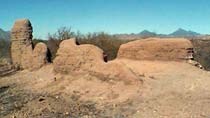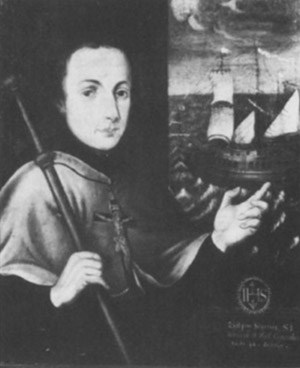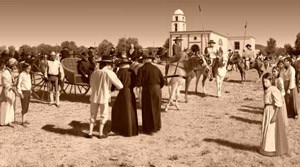
Mission Los Santos Ángeles de Guevavi
Tumacácori, Arizona
Coordinates: 31.568876,-111.050140
#TravelSpanishMissions
Discover Our Shared Heritage
Spanish Colonial Missions of the Southwest Travel Itinerary

Courtesy of the National Park Service.
While Franciscans friars were building missions in New Mexico and Texas, Jesuit priests were building missions in the northwest of New Spain to spread Spanish culture and Christianity to the Native Americans. A few miles northeast of Nogales, Arizona, six miles north of what is today the modern U.S.-Mexican border, the ruins of Mission Los Santos Ángeles de Guevavi are quietly eroding under the forces of the wind and rain. Mission Guevavi, as it is commonly called, was located in the northern portion of the Pimería Alta region of New Spain. The mission was founded by the Jesuit Order through Father Eusebio Kino in 1691, but was only occupied intermittently until it became the location of the first Jesuit head church, or cabecera, in the southwestern United States. The Pima Revolt in 1751, Apache raids, and the expulsion of the Jesuits from the Americas in 1767, led to instability at the mission and its eventual abandonment as those few who remained moved north to the mission at Tumacácori.

Artist unknown, c. 1729. Courtesy of Wikimedia Commons.
The O'odham and Mission Life
Father Eusebio Francisco Kino, a Jesuit priest, began missionizing activities in the region in 1691 when he visited and encouraged the local Pima to be baptized. Father Juan de San Martín arrived in 1701 to be the first resident priest. Working under Spanish authority, Kino founded more than 20 missions and smaller outposts throughout the arid region, which the Spanish named the Pimería Alta, today Southern Arizona and Northern Sonora.
Prior to the influence of Spanish missionaries, the local O'odham moved seasonally and planted crops along the floodplain of the Santa Cruz River. The word "Guevavi" was a Spanish phonetic attempt to record the O'odham name for the mission site; it may have come from the word gusutaqui meaning "big water," referring to the fact that water was consistently available in the streambed at that location.
As in many other places, the Spanish gave their own names to the people they encountered. The O'odham who lived along the rivers they called "Pima." The O'odham who lived and farmed in the desert, they called "Papago."
The O'odham at the missions adopted some aspects of Spanish culture. They began practicing animal husbandry, learned Spanish, and participated in parish life. Farming of traditional corn continued, with the addition of wheat, peaches, and other fruits introduced by the Spanish, all irrigated by the Santa Cruz River. Herds of cattle and sheep roamed the valley and provided hides, meat, and tallow for the missions as well as for Spanish ranches, communities, mining camps, and presidios (fort communities). Traditional ceremonies and activities like making fermented alcoholic beverages from cactus fruit continued as well, much to the annoyance of some priests.
For the first few decades, priests intermittently resided at Guevavi. As the Spanish began to increase their presence and impose more restrictions on those O'odham who joined the Spanish system, areas of resentment and resistance grew. In an event known as the "Pima Revolt of 1751," a group of O'odham led by Pima Auxiliary Captain Luis Oacicpagigua, attacked nearby communities, killiing over 100 primarily Spanish and Yaqui settlers. Just before the revolt, Father Garrucho had built the small adobe church at Guevavi that can be seen today. Father Garrucho escaped the conflict, but the Mission Guevavi was sacked. The mission was later reclaimed in 1752.

Courtesy of the National Park Service.

2013. Photo by Barnet Pavao-Zuckerman.

National Park Service photograph
Plan Your Visit
Mission los Santos Ángeles de Guevavi is a National Historic Landmark located in the Tumacácori National Historical Park, a unit of the National Park System. The visitor center for Tumacácori National Historical Park is at 1891 East Frontage Rd., Tumacácori, AZ and is open 9:00am to 5:00pm daily, except Thanksgiving Day and Christmas Day. Mission los Santos Ángeles de Guevavi is accessible January through March by reservation. For more information, visit the National Park Service Tumacácori National Historical Park website including its featured page on Los Santos Angeles de Guevavi or call 520-377-5060.
Mission los Santos Ángeles de Guevavi has been documented by the National Park Service's Historic American Buildings Survey and is featured in the National Park Service American Latino Heritage Travel Itinerary. Tumacácori National Historical Park is featured in the National Park Service Places Reflecting America's Diverse Cultures: Explore their Stories in the National Park System Travel Itinerary.
Last updated: August 19, 2016
